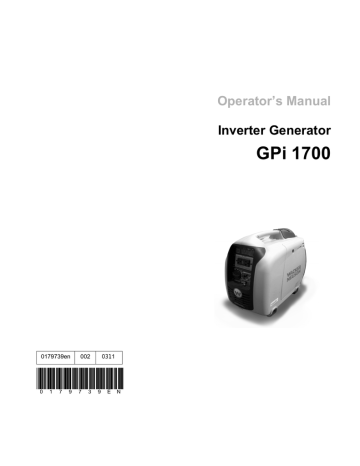- Industrial & lab equipment
- Electrical equipment & supplies
- Power generators
- Wacker Neuson
- GPi 1700
- User manual
advertisement

GPi 1700
2 Operation
Operation
DANGER
Carbon monoxide. Using a generator indoors CAN KILL YOU IN MINUTES.
Generator exhaust contains carbon monoxide (CO). This is a poison you cannot see or smell. If you can smell the generator exhaust, you are breathing CO. But even if you cannot smell the exhaust, you could be breathing CO.
f NEVER use a generator inside homes, garages, crawlspaces, or other partly enclosed areas. Deadly levels of carbon monoxide can build up in these areas.
Using a fan or opening windows and doors does NOT supply enough fresh air.
f ONLY use a generator outside and far away from windows, doors, and vents.
These openings can pull in generator exhaust.
f Even when you use a generator correctly, CO may leak into the home. ALWAYS use a battery-powered or battery-backup CO alarm in the home.
f If you start to feel sick, dizzy, or weak after the generator has been running, move to fresh air RIGHT AWAY. See a doctor. You could have carbon monoxide poison.
2.1
Overview
Generator application
This generator is an exceptionally quiet, compact, and lightweight machine designed to provide single phase power for construction, commercial, and residential applications. State-of-the-art inverter technology ensures a consistent flow of clean and stable power suitable for operating not only tools, but also delicate electronic equipment.
Safety notices Do not exceed the power output of the generator. Damage to tools or generator will occur. Refer to Technical Data.
Do not exceed the rated current limit of any receptacle.
2.2
Preparing the Machine for First Use
Preparing for first use
To prepare your machine for first use:
1. Make sure all loose packaging materials have been removed from the machine.
2. Check the machine and its components for damage. If there is visible damage, do not operate the machine! Contact your Wacker Neuson dealer immediately for assistance.
3. Take inventory of all items included with the machine and verify that all loose components and fasteners are accounted for.
4. Attach component parts not already attached.
5. Add fluids as needed and applicable, including fuel, engine oil, and battery acid.
6. Move the machine to its operating location.
wc_tx001234gb.fm
17
advertisement
* Your assessment is very important for improving the workof artificial intelligence, which forms the content of this project
Related manuals
advertisement
Table of contents
- 7 Signal Words Found in this Manual
- 8 Machine Description and Intended Use
- 9 Safety Guidelines for Operating the Machine
- 11 Operator Safety While Using Internal Combustion Engines
- 12 Guidelines for Service Safety
- 13 Label Locations
- 14 Machine Labels
- 17 Overview
- 17 Preparing the Machine for First Use
- 18 Features and Components
- 19 Lifting and Transporting
- 19 Installation
- 20 Power Requirements
- 21 Use of Extension Cords
- 22 Control Panel
- 24 Customer Connections
- 25 Grounding the Generator
- 26 Fueling the Machine
- 27 Before Starting
- 28 Starting the Generator
- 29 Using AC Power
- 30 Using DC Power
- 31 Stopping the Generator
- 31 Emergency Shutdown Procedure
- 32 Periodic Maintenance Schedule
- 34 Cleaning and Checking the Spark Plug
- 35 Cleaning the Air Cleaner Assembly
- 36 Changing the Engine Oil
- 37 Cleaning the Spark Arrester
- 38 Cleaning the Fuel Filter
- 39 Storing the Generator
- 43 Schematic Components
- 45 Engine
- 46 Generator Data